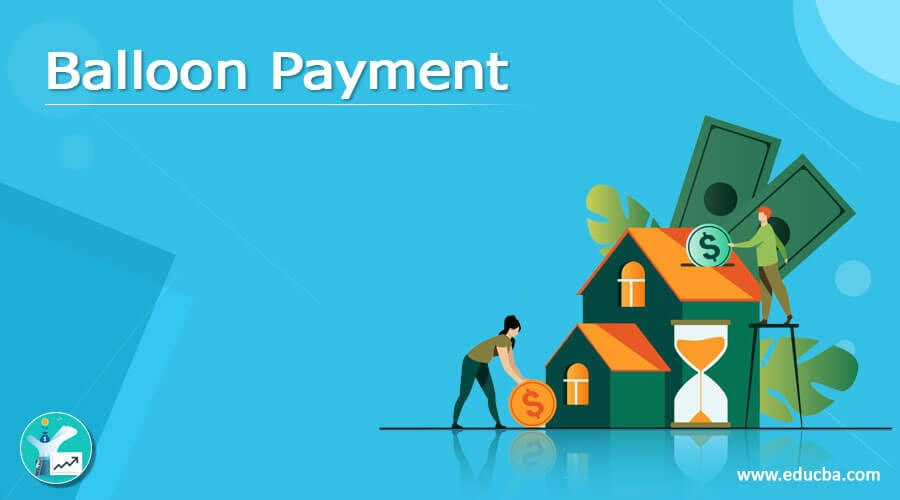Updated July 13, 2023

What is a Balloon Payment?
Balloon payment, as the term suggests, refers to a lump sum payment made by the borrower to the lender towards the loan or mortgage, usually higher than the monthly installments made towards the loan. A balloon payment is produced mainly at regular intervals or even at the end of the loan tenure.
Key Takeaways for Balloon Payment
Balloon payments and mortgages have a commercial flair to them. Since it involves more significant loan amounts and larger payments, it’s not uncommon for retail consumers to prefer to stay away from it.
With all its advantages and disadvantages, loans with balloon payments come with risks. The same should be considered before proceeding with such a financial transaction.
There is no question here to check whether balloon payments are good or bad, as it depends on the borrower and his financial obligations/requirements.
How Does it Work?
The borrower takes a short-term loan, but monthly payments to be made towards the loan are calculated as if the loan is to be repaid in a longer timeframe, say 10, 20, or even 30 years timeframe. Here if you notice, the amount to be repaid by the borrower for the loan taken for the short term may not cover the whole loan repayment, and thus the concept of balloon payment comes into the picture.
Here, the borrower takes a loan from the lender at a mutually agreed timeframe and interest rate. Once the loan transaction has taken place, parties agree on when to schedule the balloon payments and accordingly arrive at a monthly payment to be made by the borrower regularly.
It is not uncommon for the borrower to make balloon payments towards the loan at the end of loan tenure to repay the whole balance principal amount.
Example of Balloon Payment
Let’s say Mr. Peter has taken a $500,000 loan for a tenure of 5 years at an interest rate of 4%.
Now, based on the 30-year loan tenure payment calculation, the payment to be made by Peter every month will be $2,387.
Based on the above example, Peter will have to make a balloon payment of $356,780 at the end of the 5th year.
Based on mutual discussion amongst the parties, the reader may note that they may agree to a balloon payment at the beginning of the loan tenure or anytime during the loan tenure. In such a scenario, the interest charge may change accordingly.
Let’s take another scenario of the balloon payment, wherein Mr. Peter takes the loan with the same conditions. Still, the parties agree to charge only interest for the loan tenure period, with the principal repaid at the end of the loan tenure.
In such a case, Mr. Peter will pay approximately $900 monthly for five years, which will be adjusted towards interest. In such a situation, Mr. Peter can use the $500,000 immediately for his financial needs for small payments towards the interest component. This helps him in finance management.
Balloon Payments and Mortgages
A balloon payment mortgage is nothing but a loan taken, and the repayment is structured so that it already considers the balloon payments to be made by the borrower at the end of the loan tenure.
There will be an amount due to be repaid at the end of the loan, and the same will be balanced by way of a lump-sum payment, which is nothing but a balloon payment.
Application of Balloon Payments
Application of balloon payments is mainly found by organizations which may be small business owners, home buyers, businesses planning an expansion, and companies being in or entering into the development phase of the growth cycle.
Usually, these are the businesses or categories which require an initial more enormous cash outflow, with revenue-yielding activities taking up starting a couple of years.
It will be good to understand that having balloon payments structured in loan help these businesses meet the initial cash crunch and act as a great financial tool.
Advantages of Balloon Payments
- Lower monthly payments are to be made, as the calculation for monthly payments is made on a more extended tenure basis.
- Saved from the burden of high-interest rates, the person will not have to bear interest if he has to take a loan for a longer duration.
- Beneficial for people who have bulk payments coming into the business
- Helpful for people who need short-term financing
- A person may be able to fetch larger loans in comparison to the usual loan
- Useful for people who anticipate getting bulk income at particular or specified times
Disadvantages of Balloon Payments
- A default will be very detrimental, as the borrower will have to make the balloon payment in any way.
- High risk as the repayment to be made towards balloon payment is huge
- Refinancing is possible but will entail higher interest rates
- The borrower may overestimate his repaying capacity
- In case the borrower plans to sell off a particular asset to make the balloon payment, a change in a market scenario can have a significant impact on the prices of the asset
- Improper planning is a significant hindrance to balloon payment structures
Conclusion
In a few words, balloon payment means a loan that involves monthly payments of a smaller amount towards interest and principal (mostly good) and a lump sum payment at the end of loan tenure towards the principal. This large payment made at the end of loan tenure is nothing but a balloon payment, a name given because of the nature of the transaction.
Due to its nature, it’s easier to understand why such a transaction is usually seen in commercial transactions rather than consumer ones.
Recommended Articles
This is a guide to Balloon Payment. Here we also discuss the definitions, working, and examples of Balloon Payment along with the advantages and disadvantages. You may also have a look at the following articles to learn more –
